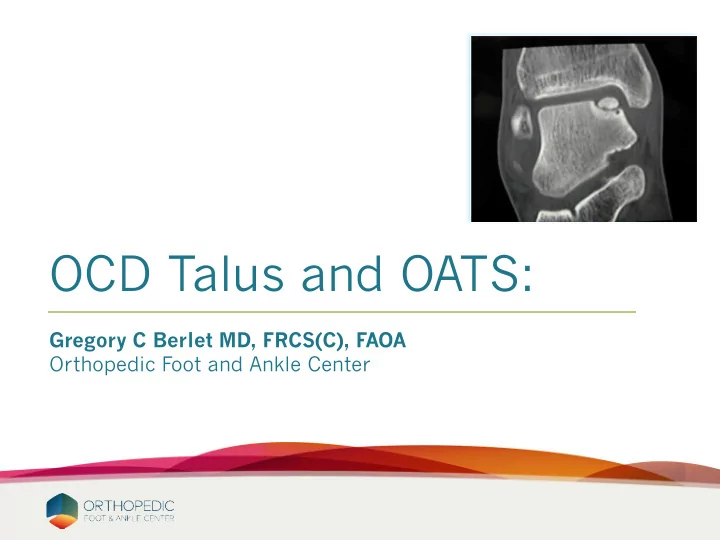

OCD Talus and OATS: Gregory C Berlet MD, FRCS(C), FAOA Orthopedic Foot and Ankle Center
Disclosures • Consultant/Speaker Bureau/Royalties/ Stock: Wright Medical, Stryker, ZimmerBiomet, DJO, Plasmology 4 , Amniox Medical, United Orthopedic Group, Paragon 28, CrossRoads, Ossio
OCD Talus: My Approach Dictated by : • Symptoms of the patient • Mechanism of injury • Size of the lesion • Containment of the lesion • Previous treatment of the lesion • Corresponding damage to the tibia
ISCRA • International Society on Cartilage Repair of the Ankle (ISCRA) • Focus groups develop consensus with the larger group participating in voting at the in person meeting Consensus Meeting of ISCRA November 2017
Our Patient • 21 year old athlete with a large OCD • With no history of injury, mechanical alignment challenges we must consider this as an osteochondrosis • Focal alteration in subchondral bone with subsequent cartilage compromise • Issues: Size (large), Bone compromise
OCD Talus: My Approach Dictated by : • Symptoms of the patient • Size of the lesion • Containment of the lesion • Previous treatment of the lesion • Corresponding damage to the tibia
Outcomes: Microfracture OLT Tol JL et al. 2000 – Meta-analysis 32 studies; 1966-1998 – Success of OLT surgeries: • Excision, curettage, drilling: 85% • Excision, curettage: 78% • Excision alone: 38% Tol … van Dijk: : FAI 21(2), 2000
Results: OFAC • Retrospective review of 189 patients • Arthroscopy + Microfracture • MRI used to determine size • Review of clinical outcomes ( 37 mo avg) Cuttica, Berlet et al: FAI 32(11), 2011
Results: OFAC • Direct correlation of size to outcome • Linear relationship of size of lesion to outcome • MRI changes may persist longer than expected Cuttica, Berlet et al: FAI 32(11), 2011
Results: OFAC vs Tol • Average lesion size in Tol = 7 mm • OFAC results deteriorated after > 1 cm • Maybe size does matter • Strategy has to be size dependent • CRITICAL SIZE DEFECT
Critical Defect Size Choi et al: • 120 ankles with talus microfracture • Failure defined as: – Repeat surgery – AOFAS < 80 ( fair or poor result ) • Defect size > 150 mm 2 ( 7 mm ) – 80% failure rate ( p < .001) Choi et al. AJSM 37(10) Oct 2009
ISCRA 2017 OATS: Indications • Primary cystic lesions > 1cm • Revision primary procedures with a lesion size >1 cm • Our patient = 1.3 cm
Osteochondral Plug Transfer cartilage bone Theoretically address both bone and cartilage injury
ISCRA 2017 OATS: Technique • A depth of 12-15 mm is the optimal depth to drill the lesion and optimal length of the graft to harvest • Congruency of the implanted graft is essential and care should be taken during surgery to achieve an articular surface as closely as possible to the native talus
ICRS 2009 Hangody: – 1178 mosaicplasty over 10.5 years Talar Mosaicplasty: – Best outcomes of all indications – >90 % good to excellent – Addresses bone defect and cartilage 8 th Annual Congress of International Cartilage Research Society 2009
Plug Osteochondral Transfer Imhoff et al: • Level 4 clinical series – 32 patients – avg f/u 84 months – AOFAS, Tegner and VAS • Results: improvement of all parameters • Partial incongruity = poorer result • Primary better than revision cases Imhoff et al, AJSM 39(7), 2011
ISCRA 2017 OATS: Auto vs Allograft • Cylindrical osteochondral allograft plugs are preferred to autograft: Contained lesions greater than 1.5 cm Knee osteoarthritis History of knee infection Patients expressing concern about donor site morbidity of the knee
ISCRA 2017 OATS: Source of Graft • Allograft plugs should be sourced from the talus, as well as matched for size and side for reasons related to cartilage thickness, morphology and congruency • There is an absence of clinical evidence to recommend in favor of or against the use of decellularized osteochondral allograft plugs
ISCRA 2017 Graft Survival: Fresh Wins • Fresh osteochondral grafts have shown viable chondrocytes >17 yrs • Sig decrease in viable chondrocytes by day 28 ( 70% viability remains ) • “ fresh osteochondral allografts should not be used if older than 28 days, preferable to use grafts not older than 21 days” Williams et al: JBJS 85A, 2003
Best Option for This Patient: OATS • Size Matters – Patients lesion is 1.3 cm • ISCRA guidelines applied: Autograft from knee (<1.5 cm) 2 plugs intersecting Plugs are flush Biologic augmentation should be considered
THANK YOU
Recommend
More recommend